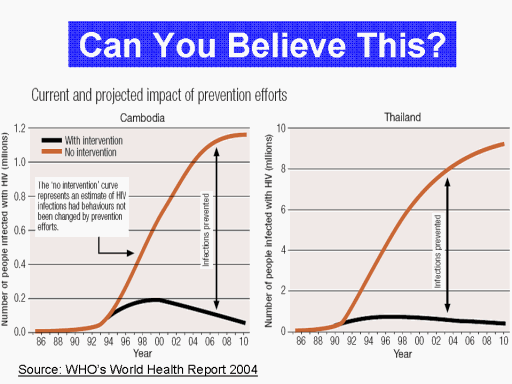| front |1 |2 |3 |4 |5 |6 |7 |8 |9 |10 |11 |12 |13 |14 |15 |16 |17 |18 |19 |20 |21 |22 |23 |24 |25 |26 |27 |28 |29 |30 |31 |32 |33 |review |
 |
Using a
curve-fitting and extrapolation model (Asian Epidemic Model), the
East-West Center and its collaborators explored the impacts of HIV
prevention efforts. They
concluded from their modeling effort that without aggressive
prevention programs, that both Cambodia and Thailand would now be
looking at expanding epidemics with 10–15% of their adult
populations living with HIV/AIDS, instead of the declining epidemics
of 1-2% currently seen. They credit the AIDS program in Cambodia
with preventing about a million HIV infections (by 2007) and the
Thai AIDS program with preventing over 6 million HIV infections by
2003. However, by applying
this same naïve logic, HIV prevention programs in Myanmar also have
to be given credit for keeping HIV prevalence at 1-2%.
These modelers totally ignore the epidemiology and transmission dynamics of HIV and have assumed for their modeling that the pattern and prevalence of sexual risk behaviors and HIV facilitating and protective factors are identical for these Asian countries and sub-Saharan African countries. What is shocking to me is that WHO swallowed this modeling – hook, line, and sinker! I would expect my grandson, who is just finishing his sophomore year in high school to know better! |